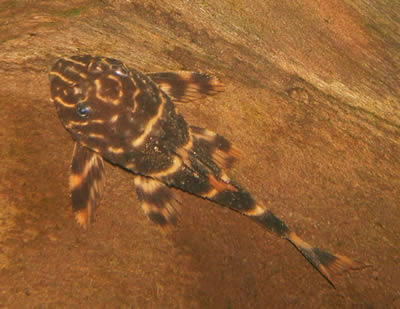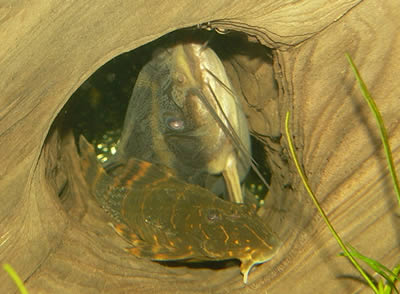Clown Pleco
Introduction to Clown pleco
The Clown pleco was described by Schaefer & Stewart in 1993 and given the scientific name Panaque maccus . In some sources, you might find the synonym Panaqolus maccus . The Clown pleco has been assigned the L-numbers L104 and L162. The Clown pleco has several common names in English, including Clown panaque and Ringlet Pleco. Some aquarium shops sell Panaque maccus under the name Peckoltia vittata , but that is a completely different species.
The Clown pleco can reach a length of 10 cm (almost 4 inches). In young specimens, the dark brown body is decorated with bright orange to white striping. As the fish matures, the base colour becomes brighter.
Just like all the other members of the genus Panaque, the Clown pleco is equipped with spoon-shaped teeth that are much wider at the tip than at the base. Another identifying characteristic is the lack of buccal papilla. The buccal papilla is a flap of skin found inside the mouth of a fish, and none of the members of the genus Panaque have such a flap.
The Clown pleco can reach an age of 18 years.
Geographical distribution, habitat and care
The Clown pleco is native is native to Colombia and Venezuela where it inhabits the Rio Orinoco drainage of the great plains.
 Young Clown pleco - Picture by Smaug |
The water should be kept around neutral when keeping Clown plecos, from pH 6.8 to 7.6. The Clown pleco is not a black water pleco. The recommended water temperature is 23-28 degrees C (73-82 degrees F). In the natural home of the Clown pleco, the parameters vary depending on season. During the dry season, the water is fairly warm (typically around 27° C / 80° F), hard and a bit alkaline (around pH 7.5). When the heavy rain starts, the water becomes cooler, softer and neutral.
The Clown pleco should never be kept in an aquarium without wood since it is a wood eating species. Ideally include several types of wood in the set up The Clown pleco does eat algae but it is not the most efficient algae eating pleco on the market. Juveniles tend to eat more algae than adult specimens. Do not force your Clown pleco to rely on natural algae growth only; always supplement with algae based prepared foods. Clown plecos can eat plants, but you can decrease the risk by giving them plenty of vegetables such as cucumber, zucchini, potatoes and lettuce. Clown plecos also need to be given occasional servings of meaty food to stay healthy. Ideally feed your Clown pleco after turning off the aquarium lights, because this is a night active species that prefers to forage for food when it is dark.
The Clown pleco produces a lot of waste and frequent water changes are therefore a must, otherwise the levels of organic waste will sky-rocket.
Aquarium set up and suitable tank mates
Since Clown plecos do not grow bigger than 10 cm (4 inches) they can be housed in 60 cm (2 feet) aquariums. Try to mimic the natural environment of Rio Orinoco when you set up the aquarium and use soft gravel or sand. Always include plenty of driftwood in the set up; it will function as both food and shelter. In the wild, Clown plecos spend most of their time inside driftwood tangles in the main river channels.
The Clown pleco might nibble on your plants so chose sturdy species if you want to include live plants in the set up. Soft broad leaved plants seem to be most tempting for the Clown pleco.
The Clown pleco is a peaceful fish that can be kept with other peaceful species in a community aquarium. It is a territorial fish, but it will only defend its territory against other members of its own species (or possibly closely related species). Territorial disputes rarely lead to injury.
Breeding Clown pleco
Unlike many other plecos, the Clown pleco is frequently bred in aquariums. Females tend to be longer than males and their bodies are plumper. When the male gets into breeding condition he will develop elongated odontodes on his head and along his dorsal fin.
If you want to breed Clown pleco, ideally set up a species aquarium and decorate it with plenty of driftwood. Hide suitable spawning caves among the driftwood. The entrance of the cave should be narrow, just barely large enough for the parents to squeeze themselves in. The length of the cave should be around twice the length of the fishes. PVC-tubes are known to be appreciated. The male will guard the eggs and should therefore never be removed from the breeding aquarium.
In the wild, Clown plecos breed when the dry season ends and the rainy season starts. The best way of triggering spawning in the aquarium is therefore to mimic such a change. The environmental changes should be combined with changes in diet. As the rainy season starts, the amount of food virtually explodes in the river and the Clown plecos can feast on all sorts of plants and small animals. You might have to mimic several dry and rainy season before your Clown plecos starts to spawn. Spawning will typically take place when the water starts to warm up again after the sudden drop in temperature.
 Clown pleco and Raphael catfish - Picture by Smaug |
Typical dry season:
• High temperature
• Hard water
• Alkaline water
Typical rainy season:
• Lowered temperature
• Softer water
• Neutral water
• Plenty of food, both vegetables and meaty food.
• Stronger current
What's in a name?
The genus name Panaque is the common name used in Venezuela for these fishes.
Didn't find the info you were looking for? Register for free and ask your question in our Aquarium forum or our Pleco forum !
Our knowledgeable staff usually responds to any question within 24 hours
Pleco Articles
Albino Bristlenose Pleco- Information on how to keep and care for albino plecos.
Alligator Pleco - A guide to keeping and caring for Bushy Nose Plecos.
Blue phantom pleco- Information on how to keep and care for Blue Phantom Plecos.
Breeding Bristlenose Catfish - Ancistrus species- How to breed Ancistrus
Breeding Whiptails- Information on hot to breed whiptail catfish species.
Bushy Nose Pleco- Information on how to keep and care for bushy nose plecos.
Butterfly Pleco- Information on how to keep and care for Butterfly plecos.
Candy Striped Pleco - A guide to keeping and caring for candy striped plecos.
Clown Pleco- Information on how to keep and care for Clown plecos in aquariums.
Common Pleco- A guide to keeping and caring for common plecos.
Golden Nugget Pleco- Information on how to keep and care for Golden nugget plecos in aquariums.
Iquitos Tiger Pleco- A guide to caring for Iquitos tiger plecos.
King Tiger Pleco- How to keep and care for King tiger plecos.
Leopard Sailfin Pleco- Information on how to keep and care for Leopard Sailfin plecos.
Peppermint Pleco- A guide to keeping and caring for Peppermint plecos.
Pleco Care- Learn how to care for plecos.
Royal Pleco- A guide to caring for Royal plecos.
Rhino Pleco- Information on how to keep and care for Rhino plecos.
Rubber Lipped Pleco- How to care for this species.
Rubber Nose Pleco- How to keep and care for rubber nose plecos.
Snowball Pleco- Information on how to keep and care for Snowball Plecos.
Sting Ray Pleco- Information on how to keep and care for sting ray Plecos aka hillstream loaches.
Spawning Bristlenose Plecostamus (Ancistrus dolichopterus)- A guide to spawning Bristlenose plecos.
Vampire Pleco- Information on how to keep and care for Vampire Plecos.
Zebra Pleco- Information on how to keep and breed Zebra plecos.
